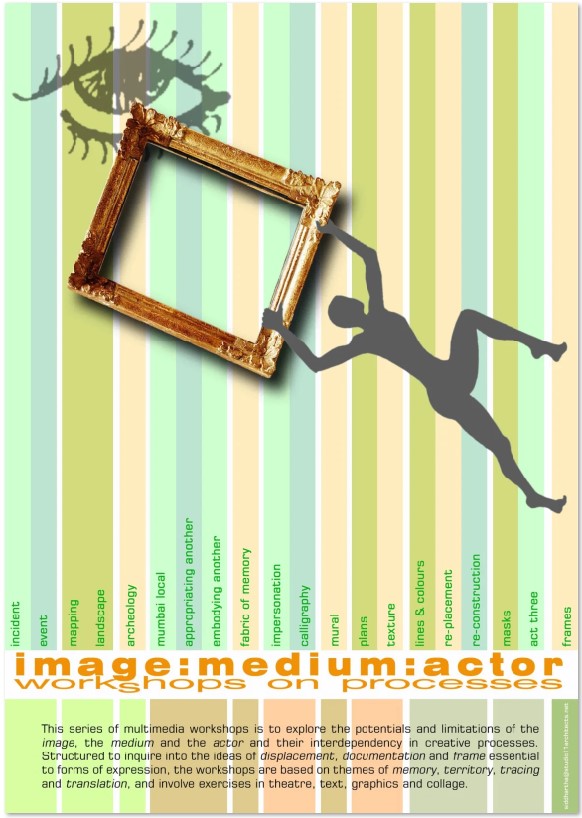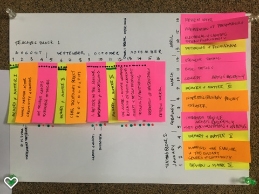Love, Labor & Chance
Learning to Teach; Work in Progress
Coming a Full Circle
It feels like a pleasant coincidence that I got the opportunity of conducting a studio at my alma mater where I started my journey as an educator a decade ago. CEPT has undergone substantial transformation since I taught here last in 2011 and ‘12. During this time I too have travelled across many institutions with my course on creativity and emotions – image:median:actor1 which I had created as an elective for CEPT. Every workshop prepared me in unknown ways for the unanticipated demands from the next. While some institutions were more generous in offering care than others and some students more skilled & enthusiastic than others, most institutions still do not consider it important to make students value and consciously engage with their bodies, memories, emotions and associations. Ignoring the self in the interest of technical skill development. The inadvertent & inevitable question within my post-workshop catharsis was, ‘After such intense and vibrant processes and works what do the students go back to tomorrow?‘ The desire for long-term engagement with students had taken root inside me.
Embodied Knowledge & Facilitation
The opportunity of leading L4 – the first year of specialisation at IIAD’s faculty of Interior Architecture between January 2019 & June 2020 allowed me to integrate my concerns around architecture, body and memory with the institute’s mandated trajectory of eliciting students’ ’embodied knowledge’. As a young institution affiliated to a UK university, IIAD has an elaborate design pedagogy in place applicable across all of its three Faculties: Fashion, Communication and Interior Architecture. The Common Foundation Program – the currently popular institutional hobby – has its own framework for inculpating the discipline of learning from doing. I was more than glad to incorporate mediums which I feel are necessary for an initiation into the complex discipline of architecture: the sensual social art responsive to real human desires and feelings2. Text, Theatre, Collage, Graphic & Spatial Representation, Sculpture, Origami, Knitting and Nature Walks were all part of the preparatory studies in body, space, processes, materials, environment etc., contributing to the design projects.
I feel good to have stepped up to the challenging institutional demands of structuring the entire term, drafting briefs, establishing assessment criteria and rubric and providing feedback and feedforward to students. Shruti, my co-tutor, did very well in assisting my ambitious efforts and also running Contextural Studies – a quarter of the course – on her own. The two workshops on pedagogy by Soumitri Varadarajan3 and Vishnu Kant4 that IIAD organised towards the end of 2019 and early 2020 respectively, were wonderful, insightful and humbling experiences.
Unfortunately my trajectory at IIAD came to an abrupt end in the middle of the pandemic induced disruptions. However, I am also relieved in a way because it was impossible to go on – exchanging online with students the significance of embodiment, emotions, emotional memories and shared space.
my structure for L4 -the first year of specialization in Interior Architecture – at IIAD included diverse material workshops and visual & spatial representation exercises in addition to incrementally complex design exercises
Gestation
Over the past nine months, I have continued working in diverse mediums, as I am accustomed to doing. Video editing is the new inclusion in my skillset. Conducting interviews5 of mentors on issues emanating from the pandemic and the ensuing lock downs, engaging with the eclectic group of contemporary musicians Chaar Yaar, creating logos6 and courses7, offering online workshops to teachers and writing8 – both lyrical as well as prosaic type – have been many of the silver linings of creativity that I have tried to carve out in these terribly dark times that we are going through with respect to public health, society and politics.
All this work, particularly over the past couple of years, now seems to have been in preparation for the next half year: BODY | MEMORY | ARCHITECTURE – a course for students of architecture, developed over the past three months (and, of course, from our experiences over decades). We have gone through many iterations of the briefs and presentation since CEPT’s open invite for studio tutors was discovered in September by Sukhmani – my better half in luck and judgement. CEPT demands a lot of work in preparing the brief. Starting with a 10 minute PPT with an unyielding voice-over, to arriving at a five minute emotive video, the iterations have helped considerably – foremost in walking the talk: leading by example in what we expect from our students.

Hope & Anxiety
In spite of all the hard work, I can barely conceal my anxieties about the impending registration process. What will be our unit’s position in the order of students’ preference? What are the odds that 15 students opt for it as the first preference* and spare themselves and us the insufferable process of judging whether one is ‘good enough‘? I remember John Britton’s opening words to his theatre master class: Self with Others9, making my eyes swell with tears of gratitude, “We are all here; we are good enough!” I recurrently recollect Tapan Chakravarthy’s words admonishing stiff teachers, “The student has done everything that you and the institution asked them to do to be part of this batch and is now standing at the threshold [of your space of learning]. What do you mean, ‘They are not interested in learning…’? It is your job to get them interested!”10
We have already gone through one interview process for the studio in selecting the TA. It didn’t feel right to write to others, ‘We regret not being able to select you.’ They were all interested and good enough. No matter how much I explain to them the insignificance of this setback on who they are, rejection, I feel, remains one of the most difficult situations to negotiate. Evaluation within a course is a different matter where the tasks and assessment criteria are explicitly mapped in a closed system and deliverables are graded accordingly. Job interviews, however clearly structured, leave a lot to chance and a lot more to the ability of proving one’s worth. In my idealistic and romantic perspective this is an intended evil of a societal structure that emphasizes making a living over simply living. I don’t have alternatives, but perhaps we can talk about it sometime.
Notwithstanding our love and labour, what the studio creates through its course depends substantially on the 15 students who will be participating in it. There are a host of processes and protocols that we have put in place to make this dreaded online semester alive and vibrant: weekly reviews, peer reviews and a reflective journal in the form of a blog, of which this writeup is the first offering.
Notes & References
- https://www.designpendulum.com/image-medium-actor/
- Charles W. Moore & Kent C. Bloomer in Body, Memory & Architecture; Yale University Press
- http://soumitri.com.au/
- https://www.facebook.com/PropelCurriculum
- https://www.designpendulum.com/portfolio/the-vessel/calendar/
- https://www.designpendulum.com/portfolio/compoundeye/logos-motifs/
- https://www.designpendulum.com/image-medium-actor/lt3/
- https://www.designpendulum.com/portfolio/textures/
- the next best thing to working with John is reading his brilliant little book: Climbing the Mountain; audiobook: https://payhip.com/b/wVWR PDF: https://payhip.com/b/hrxq
- personal conversation; Tapan is an architect with decades of teaching experience; he recently retired as the Region Head of Pearl’s Interior Architecture Faculty








 malkum
malkum